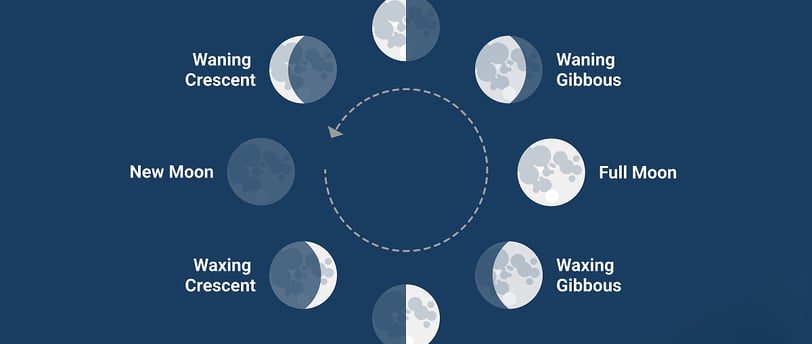Understanding Lunar Phases: A Complete Guide to the Moon's Cycle, Cultural Significance, and Scientific Impact
Explore the captivating journey of the Moon's phases in this comprehensive guide. From the science behind lunar cycles to their cultural, ecological, and spiritual significance, learn how the changing shape of the Moon influences everything from tides to human behavior. Discover the beauty and mystery of the lunar cycle and how it shapes life on Earth.
SCIENCE
Marshal Samuel
12/22/20246 min read


Lunar phases, the mesmerizing dance of light and shadow that unfolds in the night sky, have captivated humanity for centuries. The shifting shapes of the Moon, from the crescent sliver of a new moon to the radiant circle of a full moon, hold profound significance in various cultural, spiritual, and scientific contexts. Understanding lunar phases involves delving into the complex dynamics of the Moon's orbit around Earth, the interplay of gravitational forces, and the influence of sunlight. In this article, we embark on a journey to explore the fundamentals of lunar phases, their cultural and mythological meanings, the factors that shape them, and the impact they have on Earth's systems and human endeavors. Join us as we unravel the mysteries and marvels of the lunar cycle.
Introduction to Lunar Phases:
So, you know that big shiny thing that hangs out in the night sky? That's our Moon. And guess what – it doesn't always look the same every night. Welcome to the world of lunar phases!
The Basics of Lunar Phases
Let's break it down: lunar phases are the different shapes the Moon appears to take on as it orbits around the Earth. From a sliver of light to a full glowing orb, these phases change in a predictable pattern that has fascinated humans for centuries.
Importance of Studying Lunar Phases
Why should we care about these cosmic shape-shifters? Well, understanding lunar phases can help with everything from predicting tides to planning the best nights for stargazing. Plus, it's just plain cool to know what's happening up there in the night sky.
Understanding the Moon's Orbit
Ever wonder how the Moon manages to pull off its nightly wardrobe changes? It's all in the dance of its orbit around Earth.
Overview of the Moon's Orbit around Earth
The Moon doesn't just hang out in one spot – it's in constant motion around our planet, completing a full orbit roughly every 27.3 days. This orbit is what creates the different lunar phases we see from Earth.
Inclination and Eccentricity of the Lunar Orbit
But wait, there's more! The Moon's orbit isn't a perfect circle – it's slightly tilted and elongated, which adds some extra flair to its journey. These orbital quirks influence the timing and appearance of lunar phases in subtle but intriguing ways.
The Eight Primary Lunar Phases
Alright, let's get down to business and meet the main players in the lunar phase lineup. Here are the top eight phases you'll want to know about:
New Moon
Waxing Crescent
First Quarter
Waxing Gibbous
Full Moon
Waning Gibbous
Last Quarter
Waning Crescent
Factors Affecting Lunar Phases
Just like any good celestial phenomenon, lunar phases aren't just about the Moon – there are some outside forces at play too.
Gravitational Effects on Lunar Phases
Gravity isn't just a concept that makes things fall – it also influences the shape and timing of lunar phases. The gravitational tugs from the Earth and the Sun create a dynamic dance that affects how we see the Moon from down here.
Impact of Sunlight on Lunar Phases
Remember how the Moon doesn't have its own light? It's all about that reflection game with the Sun. The angle and intensity of sunlight hitting the Moon determine the distinct features of each lunar phase, giving us those mesmerizing lunar displays we love to gaze at.
Cultural and Mythological Significance of Lunar Phases:
Historical Beliefs and Stories Related to Lunar Phases
The waxing and waning of the moon have captivated human imagination for centuries. From ancient civilizations attributing lunar phases to deities and supernatural forces to folklore linking them to werewolves and witches, the moon has woven itself into countless myths and legends.
Modern Interpretations and Traditions around Lunar Phases
Today, lunar phases continue to hold cultural significance. Some people believe that certain moon phases can influence mood or behavior, while others incorporate lunar cycles into spiritual practices like meditation or manifestation rituals. Whether you're a believer or a skeptic, the moon's influence on culture endures.
Studying Lunar Phases: Tools and Techniques:
Observational Tools for Monitoring Lunar Phases
Traditionally, stargazers have relied on telescopes, binoculars, or even just their eyes to observe the changing face of the moon. By tracking the moon's cycles over time, astronomers and enthusiasts can deepen their understanding of lunar phases and celestial mechanics.
Digital Resources and Apps for Tracking Lunar Phases
In the digital age, keeping up with lunar phases is easier than ever. With a plethora of apps and online tools available, anyone can access real-time information about the moon's current phase, upcoming eclipses, and even lunar calendars for planning special events or rituals.
Impact of Lunar Phases on Earth's Systems:
Ecological Effects of Lunar Phases
The moon's gravitational pull doesn't just affect ocean tides—it also influences animal behavior, plant growth, and even the Earth's climate. Studying the ecological impacts of lunar phases can provide valuable insights into how interconnected our planet's systems truly are.
Animal Behavior and Lunar Phase Influences
While scientific evidence linking lunar phases to animal behavior remains inconclusive, many people swear by the idea that a full moon can bring out the "crazy" in people. Whether it's just a psychological effect or a cosmic coincidence, the notion of lunar phase influences on animal behavior continues to spark debate and curiosity.
Future Research and Exploration of Lunar Phases:
New Frontiers in Lunar Phase Research
As technology advances, researchers have new opportunities to delve deeper into the mysteries of lunar phases. From studying the moon's impact on Earth's atmosphere to exploring lunar cycles on other planets, there are endless frontiers waiting to be discovered.
Potential Applications of Lunar Phase Studies
Beyond mere curiosity, understanding lunar phases can have practical applications in fields like agriculture, wildlife conservation, and even space exploration. By harnessing the power of lunar knowledge, we can unlock new possibilities for how we interact with and learn from the celestial dance of the moon. As we gaze up at the night sky and witness the ever-changing beauty of the Moon's phases, we are reminded of the interconnectedness of the celestial world with our daily lives. From ancient rituals to modern scientific discoveries, lunar phases continue to inspire wonder and curiosity. Whether you are a stargazer, a scientist, or simply someone who appreciates the enchanting glow of the moonlight, the study of lunar phases offers a gateway to deeper understanding and appreciation of the universe we inhabit. Let the captivating cycle of the Moon's phases guide you in exploring the wonders of the cosmos and embracing the magic of the night sky.
FAQ
Why do we see different lunar phases? The different lunar phases occur because of the Moon’s orbit around the Earth and the way sunlight reflects off its surface. As the Moon orbits Earth, we see different portions of its illuminated side, creating the various phases. At the New Moon, the Moon is between Earth and the Sun, so we can't see it from Earth. As it moves in its orbit, more of the illuminated side becomes visible, leading to phases like the Waxing Crescent and Full Moon. After the Full Moon, the visible portion decreases again, leading to the Waning Crescent before the cycle starts anew.
How long does it take for the Moon to complete one full cycle of phases? The Moon takes about 29.5 days to complete a full cycle of phases. This period, known as a lunar month or synodic month, is the time it takes for the Moon to return to the same phase (e.g., from one Full Moon to the next).
Do lunar phases have any practical applications in daily life? Yes, lunar phases have practical applications in several fields:
Tides: The Moon’s gravitational pull causes the rise and fall of ocean tides, which are most pronounced during the New Moon and Full Moon when the Sun and Moon’s gravitational forces align.
Agriculture: Some farmers use the lunar calendar to determine the best times to plant, harvest, or prune, based on the belief that certain phases can affect plant growth.
Cultural and Spiritual Practices: Many people use lunar phases for timing rituals, meditations, or manifestations. Certain phases are believed to be more conducive to specific activities (e.g., the New Moon for setting intentions, the Full Moon for completion or release).
Space Exploration: Understanding lunar phases is crucial for space missions, particularly those that involve the Moon. The timing of lunar phases can influence the safety and efficiency of lunar landings and explorations, as well as the amount of sunlight available for solar-powered equipment.


Share this Article on:
About Us
Shop, Learn, and Explore – your ultimate destination for trendy products and insightful blogs! Dive into the worlds of tech, health, finance, sports, and entertainment while discovering unique products curated just for you. Whether you're here to shop or to gain knowledge, Reboundr offers a seamless blend of inspiration and discovery. Join us today for a truly one-of-a-kind experience!
Contact Us
Subscribe for our Free Newsletters for latest updates!
contact@reboundrofficial.com
+91 727 660 779
© 2024. All rights reserved by @ReboundrOfficial.
